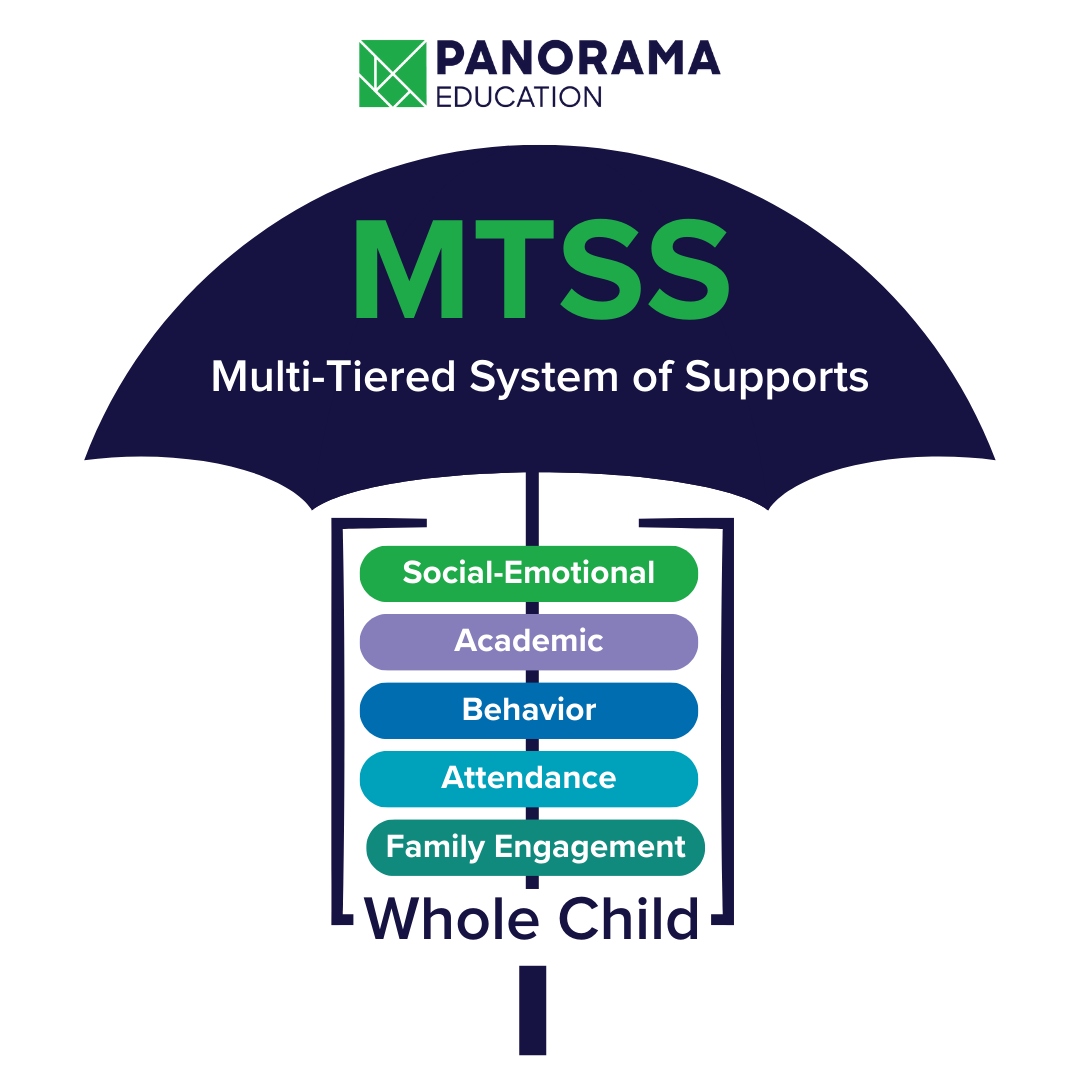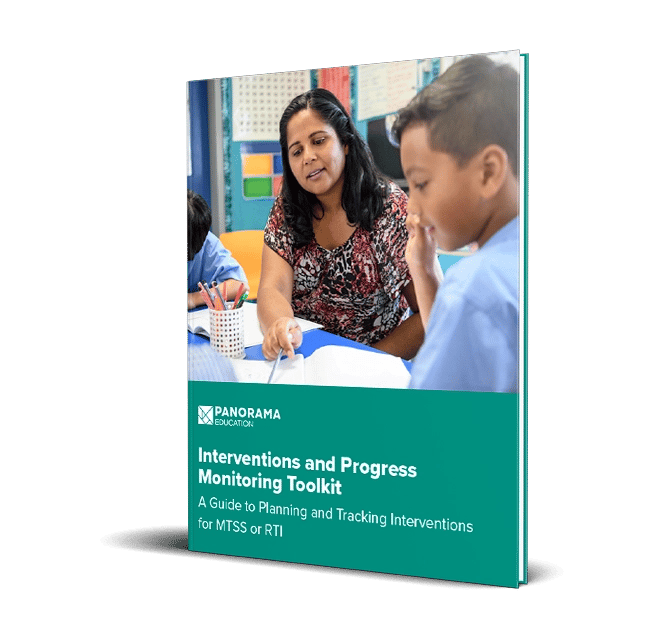Facing widespread achievement gaps, educators and district leaders are searching for ways to intervene before students fall behind. Many districts have turned to tiered frameworks of support like Response to Intervention, or RTI.
The RTI model has persisted for twenty years because of its focus on data, research, and a strong foundation. Plus, research suggests that RTI improves both systemic and individual student outcomes.
If you’re looking to get started or improve your current RTI implementation, this comprehensive guide is for you. We’ll take a look at the key components of RTI, best practices for a quality implementation, and the difference between RTI and MTSS.
Strengthen your RTI with free templates for interventions and progress monitoring
Table of Contents:
History of RTI: A Foundation in Special Education
What’s the difference between RTI and MTSS?
RTI Best Practices for District Leaders
|
Key Takeaways:
|
What is RTI?
RTI, or Response to Intervention, is an educational framework that uses a tiered model to identify and support students with research-based interventions and high-quality instruction. As the name suggests, RTI consists of monitoring whether or not students are responding to their interventions and making expected improvements.
The goals of implementing RTI often include:
- Improved student outcomes and academic performance
- Early identification and support before students fall too far behind
- Reduction in special education referrals
- Improved core instruction (Tier 1)
- Support for all students, including diverse learners
History of RTI: A Foundation in Special Education
RTI became federal law when the U.S. Department of Education reauthorized the Individuals with Disabilities Education Act (IDEA) in 2004. Therefore, it has a strong connection to supporting students with special needs.
However, RTI is not a special education program. While RTI can be used to identify students with learning disabilities, its primary purpose is to support all students. An RTI framework is intended to support students early and ultimately decrease the number of referrals to special education services. RTI and special education work hand in hand to ensure that all students are receiving adequate support.
The US government further clarified that an RTI framework enables districts to “more accurately distinguish between children who truly have specific learning disabilities from those whose learning difficulties could be resolved with more specific, science-based, general education interventions.” (emphasis added)
The effectiveness of RTI rests on the quality of general education interventions to set an appropriate foundation for all students. Only then can educators more accurately identify students who need additional support.
Key Components of RTI
3 Tiers of Support
In the RTI framework, students are distributed across multiple tiers depending on their needs. Students can be in different RTI tiers across subject areas. For example, a student may need Tier 2 support in math, but only Tier 1 support in English.

Tier 1: All
Universal classroom instruction that all students receive. Approximately 80% of students should respond proficiently to Tier 1 instruction, so it must be highly effective.
Example Tier 1 Instruction: Classroom read-aloud, core phonics instruction
Tier 2: Some
Targeted, small-group instruction with interventions for those who need additional support after receiving Tier 1 instruction. Approximately 15 to 20% of students will need Tier 2 supports.
Example Tier 2 Intervention: Story Mapping graphic organizer to visualize the structure of a story
Tier 3: Few
Individualized, intensive instruction to address specific skill gaps for about 1 to 5% of students. These students have received both Tier 1 and Tier 2 instruction.
Example Tier 3 Intervention: 3H Strategy for support with reading comprehension questions
💡 Keep in mind that students in Tier 2 and Tier 3 are not removed from core classroom instruction. Rather, they receive interventions in addition to Tier 1 instruction. Students in Tier 3 receive all three levels of support.
High-Quality Instruction
A house built on a wobbly foundation can never be solid, despite its quality materials and expert craftsmanship. So too does the RTI framework depend on the quality of instruction for all. Curricula and strategies should be based in solid research, and educators should be able to implement them with fidelity.
Research-Based Practices
One way to ensure the quality of instruction is to use research-based or evidence-based practices. Interventions should be rooted in scientific research that demonstrates their effectiveness. Both Tier 2 and 3 interventions and Tier 1 universal instruction should be based in research and proven to be effective.
Targeted Interventions
Districts should have a vetted intervention library that consists of high-quality, research-based options for classroom teachers and educators. If a student doesn’t respond to Tier 1 instruction, educators shouldn’t be left grasping at straws for what to do next. Tier 2 and 3 interventions should be a seamless part of instruction.
Data-Based Decision-Making
You can’t tell if something is working without data at every stage of the process. Baseline assessment data will help educators properly understand the “before.” Progress monitoring is an essential component of RTI where educators regularly check in on how an intervention is working. Summative assessments will show the ultimate picture of effectiveness.
Regular data meetings give educators an opportunity to analyze and reflect on data. An RTI data platform can make this process easier for both teachers and administrators to understand the full picture of student achievement.
.png?width=772&height=506&name=student%20overview%20life%20skills%20(3).png)
Panorama Student Success: District Overview. Demo data displayed.
Make your data team meetings more efficient with Panorama Student Success, a comprehensive platform to view data, log interventions, and collaborate on plans. Leverage school and district data dashboards to monitor performance and make informed decisions.
What’s the difference between RTI and MTSS?
When the Every Student Succeeds Act (ESSA) was passed in 2015, another acronym entered the conversation: MTSS, or multi-tiered system of supports.
MTSS is an organizational framework used in education settings to ensure that all students’ needs are met through increasingly targeted interventions across three levels of support.
Sound familiar?
Some schools use the terms “RTI” and “MTSS” interchangeably, while others consider MTSS a replacement for RTI. However, MTSS is actually an umbrella term that encompasses many tiered frameworks. RTI is considered an example of an MTSS. Other examples include PBIS and tiered frameworks for improving attendance and family engagement.

Another key difference between MTSS and RTI is the scope. MTSS is a comprehensive systematic framework that goes beyond academics to support the whole child. RTI is primarily an academic framework, although some schools use it for behavior as well. MTSS considers how factors like behavior, academics, and life skills are interwoven and impact a student’s overall achievement.
How to Get Started with RTI
Audit Your District’s Current Process
It’s hard to begin a journey if you don’t know where you started. Conduct a self-assessment to take stock of your district’s current state of affairs. This includes but is not limited to:
- Standard operating procedures
- Interventions in use
- Planned assessments
- Student academic data (including percentage of students receiving support outside the classroom)
- Relevant roles (teachers, interventionists, etc.)
Try not to record your “best case scenario” or ideal process. Remember that the goal is to find areas for improvement, so be honest with how things are going.
Begin with a Quality Assessment
Effective change starts with quality student data. Universal screening data will inform most RTI actions, so make sure you have recent data with all the information you need to understand student performance. Select the most efficient screening tool, and administer it well to ensure the highest quality data.
Additionally, survey your educators about your district’s current strengths and weaknesses. Since they will be enacting the majority of the RTI process, you want to make sure their needs are met. This will also help district leaders gain teacher buy-in for implementing an RTI model.
Start with Building a Strong Tier 1
Core instruction is essential to a strong RTI. Tier 1 is where both teachers and students will spend the most time, so it must be a priority in lesson planning to meet the majority of the classroom’s needs. What do the majority of your students need to be successful?
If the content is above the heads of too many students, it is not appropriate for Tier 1. Tier 1 should not be aspirational—it should be reflective of your current reality. Emphasize grade-level standards, but meet students at their current ability level.
Implement Effective Interventions
Evaluate the list of your current interventions to determine if they are research-based and effective. Use tools like the What Works Clearinghouse, Evidence for ESSA, and EdReports to vet interventions. Keep interventions with strong evidence of effectiveness that your educators report being able to implement with success.
Then, build out any gaps in your intervention menu to address specific skills. Get started with these 18 research-based interventions recommended by our team of experts.
Explore 1,000+ research-backed and evidence-based interventions across all RTI tiers with Panorama Playbook. Districts can configure Playbook content to their unique strategic goals, needs, and norms.
Collect & Analyze Data Regularly
Set the stage for a culture of data-based decision-making by routinely analyzing data and making action plans. Set expectations for frequently gathering progress monitoring data to determine whether interventions are working.
Organize data teams across your district where educators can reflect on data and problem solve solutions. Look at individual student data along with overall trends. If student proficiency rates overall are not improving across assessment administrations and years, then your RTI process may need to be adjusted.
Refine, Rinse, and Repeat
Go into the process knowing that RTI is not a one-and-done solution. It requires continual refinement to improve both the district implementation and student performance. Conduct an RTI self-assessment after educators have gotten a feel for the new framework. Use the data to look back on processes and find room for improvement.
RTI Best Practices for District Leaders
Districts looking to roll out an RTI process should prioritize a successful implementation with strong leadership and quality support for educators. Remember, Rome wasn’t built in a day, so don’t expect perfection in your first year. New processes like RTI take time to roll out effectively.
Be an RTI role model. Know the inner workings of your district’s RTI process and sing its praises.
Ensure effective communication and collaboration. Let teachers know who they can go to if they have questions. Help them roll out the new process, and expect some growing pains.
Build a strong RTI team. Look for educators with diverse roles and strengths across curriculum and intervention planning. Solutions-oriented individuals and those with an eye for data would be a good fit.
Administer effective professional development. Educators cannot get started if they do not know expectations and reasoning behind a new educational framework. Make sure the PD is worth their time with actionable strategies and valuable information.
With these tips, your district will be able to roll out a successful RTI initiative to close skill gaps and improve student outcomes. You’ll soon see how RTI can eliminate the guesswork of how to support every student. And overall, you'll witness improvements in academic achievement and beyond.
Build out your RTI programming with our free interventions & progress monitoring toolkit
|
Frequently Asked Questions How can our district determine if the RTI process is working? How can families be involved in supporting RTI efforts and understanding their role? What are topics should be addressed in professional development about RTI for teachers?Teachers need training in understanding RTI principles, administering and interpreting assessments, using data to inform instructional decisions, and implementing evidence-based interventions at each tier of support. Professional development sessions should also focus on strategies for differentiated instruction, classroom management techniques, and collaborative practices that enhance the overall effectiveness of RTI. Ongoing support and coaching help teachers implement interventions with fidelity and adapt strategies based on real-time data. |




.jpg)


